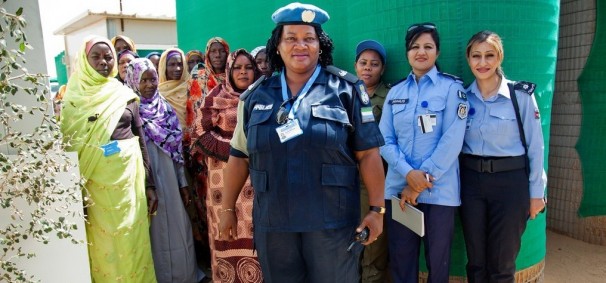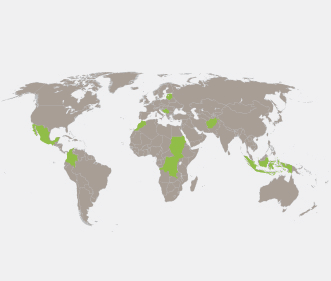Police reform is a primary component of any security sector reform (SSR) effort, especially since police are seen as the central institution for the protection and security of the population in most nations. Often, police are viewed negatively as agents of the state in times of conflict, frequently serving as enforcers or informants and thus creating a barrier of fear and mistrust between the citizen and the state. In post-conflict societies, it is essential to redefine the role of the police and rebuild the structure and citizen accountability mechanisms.
A crucial component of this reform is gender recognition. With the variance in male and female roles often resulting in unequal access to power or security, gender specific security problems arise. These safety issues can be addressed through increased group representation in the police. Increased women in the police can be a positive influence and change the way that women’s interests and needs are respected. Gender parity must be applied at all levels of the reform process, ensuring that the principles behind gender equity are assimilated into any and all stages of SSR planning and implementation.
Police reform is “the transformation of a policing organization into a professional and accountable police service that is responsive to the needs of the local communities.” Gender Sensitive Police Reform (GSPR) is the application of a gender analysis, whereby gender parity is integrated in each stage of the restructuring process. Varying degrees of access to power and security and different social roles/behaviours, especially in post-conflict settings, result in situations where gender based insecurity arises. Thus, GSPR focuses on addressing and combating these insecurities from a gender sensitive standpoint by ensuring a more responsive and representative police force that is ready and able to meet these challenges.
The difficulty is that this GSPR definition is a nebulous concept designed to be all encompassing. Problems arise when implementing GSPR programs, as there are no criteria for governments to follow, no standard for policy makers to use as a foundation, and no way to establish whether or not concrete reform is taking place.
The question then arises, what exactly is GSPR? What does GSPR entail? What are the indicators of GSPR success? And where can we see comprehensive successful restructuring in practice? There have been a number of highly visible success stories that the UN and other agencies tout as successful examples of engendered police reform. Liberia and Timor-Leste are notable examples, as is the all female UN peacekeeping force from India. The commonality between these cases is the emphasis placed on the number of women in the force. While the increased percentage of female officers is certainly a positive sign, it is not and should not be considered the primary measure of success. For successful GSPR, reform must be comprehensive and tackle the endemic bias that perpetuates gender discrimination within security agencies.
Practically, this can include the following measures: gender quotas, either within the ranks or in recruitment efforts; active and regular merit based promotion of female officers to command positions; development of specialized units designed to focus on gender specific needs, especially in areas with high levels of violence against women; and regular gender sensitive training for incoming and existing officers. To have comprehensive reform means that policies and changes must happen at all levels, not just in one token area. Moreover, isolated measures are unlikely to make an impact, i.e., the presence of a quota is meaningless unless other gender sensitive measures are taken in tandem that facilitate the inclusion of women and support gender equality at all levels. Only when all these factors are addressed will any gender reform efforts be both comprehensive and have the greatest chance of success.
Two countries that stand out in their gender reform efforts are Sierra Leone and Nicaragua. Both nations share a history of conflict and unstable political climates. Each country struggles with combating gender and sexual based violence (SGBV) and rebuilding trust in authoritative bodies. What sets both countries apart is their commendable approach to GSPR. Both Nicaragua and Sierra Leone have demonstrated that a successful and comprehensive approach to police equity is not only feasible, but possible at multiple levels and can help shape the operational backbone of the police force.
For example, Nicaragua’s police force has nine guiding principles, one of which is the inclusion of gender perspectives. They also boast one of the highest percentages of female officers in the world, having reached 40 percent in 2007. Women are found in high-ranking authoritative positions with upwards of 50 percent of senior police positions filled by women, including the highest rank of General Commissioner. In addition to these structural changes, specific action plans were implemented to improve equal opportunity access, develop SGBV training, increase transparency, and enforce merit based promotions. While lacking a specific quota for women, the national police force developed new recruitment criteria specifically targeting women, including modified height requirements and female specific physical training. The result is increased legitimacy, public trust, and increased gender parity within the forces.
Gender based violence was a hallmark of Sierra Leone’s decades long conflict. Yet, contradictory to expectations, Sierra Leone emerged as one of the strongest implementers of GSPR. Initially, police support for victims of SGBV was minimal, resulting in a reluctance to report crimes. In response, specialized Family Support Units were established in 2001 and tasked with combating the sexual and physical violence, as well as supporting the primarily female victim population. Substantial training on gender, sexual and domestic violence was also provided to police.
The Sierra Leone Police (SLP) enacted key policies to bolster gender mainstreaming objectives, including a strong sexual harassment policy. To enhance their ranks, the SLP introduced a new promotion and recruitment model that served to hasten the advancement of female officers. With its use of gender quotas, by 2011 this model increased the number of female officers by almost 18 percent. A significant increase in high ranking female roles, including the position of Assistant Inspector General, is also visible. A key component to this comprehensive reform practice is the gender assessment that the SLP undertook in 2011. This helped not only articulate the demonstrated successes but also identify the challenges and address identified restructuring issues.
Both cases illustrate the importance of a comprehensive reform model. To move ahead with successful and sustainable GSPR, emphasis should be placed on a multistage and multifactorial approach that simultaneously addresses various facets of the reform process. The presence of one or more indicators in a country does not necessarily mean that they now have a gender sensitive police force; rather they show that the country/police force has the will and commitment to pursue this avenue. With the will in place, the battle for reform is at least half done.
Heather Murphy holds an M.Sc from Uppsala University and has spent over 10 years leading international development initiatives.
Tags: gender sensitive police reform, Nicaragua, Sierra Leone






 Visit the Centre for
Visit the Centre for